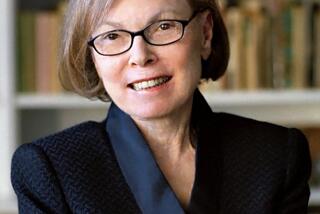Diaries Fill Out Pages in Poet’s Life
LONDON — The appalling death of American poet Sylvia Plath turned a spotlight on her tumultuous marriage to British poet Ted Hughes that has never dimmed.
In the 37 years since Plath gassed herself in the kitchen of her London flat at the age of 30--after putting out milk and cookies for the couple’s sleeping children--scholars and admirers of two of the 20th century’s most famous poets have fought incessantly about who was responsible for her suicide.
It had seemed the grim argument might be put to rest with Hughes’ death in 1998 of cancer. That came a few months after Hughes, Britain’s poet laureate, published “Birthday Letters,” his collection of passionate poems about Plath and their seven-year marriage.
But next month’s publication of her uncensored diaries, “The Journals of Sylvia Plath,” in Britain and the U.S. is certain to reignite the debate and intensify the public’s fascination with modern poetry’s first couple.
“They were Dionysian figures in an Apollonian time,” said Peter Forbes, editor of the London-based Poetry Review. “They were larger than life. People love big love stories and, in a strange way, big tragedies. They want to get to the bottom of the mystery, but they never will.”
The journals offer a few more clues. Plath published one book of poems before she took her life in 1963. A second, more powerful book, “Ariel,” was published after her death, as was her autobiographical novel, “The Bell Jar.” Her “Collected Poems,” published in 1981, won the Pulitzer Prize, and about a third of her journals, heavily censored by Hughes, appeared in 1982.
She became a martyr to many feminists who saw Hughes as the villain who controlled Plath in life and her legacy after her death. Hughes left her for another woman shortly before Plath’s suicide, something she also had attempted before they met. As the executor of Plath’s estate, he was responsible for her posthumous publications.
In the journals, Plath says that the day after she met Hughes in 1956, she wrote the poem “Pursuit,” in which she predicted that their relationship would be the end of her:
There is a panther stalks me down:
One day I’ll have my death of him.
But the journals, excerpted this week in the Guardian newspaper, build on “The Bell Jar” to reveal a tormented woman whose moods swung wildly between “apple pie happy,” self-loathing and despair.
She is alternately elated with Hughes and despondent.
“Living with him is like being told a perpetual story: His mind is the biggest, most imaginative I have ever met. I could live in its growing countries forever,” she wrote July 22, 1956.
And the next day: “Alone, deepening. . . . The hurt going in, clean as a razor, and the dark blood welling.”
She also vacillates between the conventional role for women of her time and an unconventional, sexually liberated one.
Disappointing to scholars is that the new journals contain nothing from the tormented and fertile last years of Plath’s life. Christina Britzolakis, a professor of comparative literature at the University of Warwick in Coventry, England, said two volumes are missing, one of which Hughes said he destroyed to keep the children from reading it.
“These journals are a filling-out of the fragments that had been censored in the earlier edition because either they related to people who were still alive and who it was thought might be offended, or because they related to Plath’s sexuality and sexual relationships with Hughes and other men,” Britzolakis said.
She said they will shed light on the poetry, as they are “very much a writer’s diaries, a storehouse of materials for writing.”
But while the journals may focus some attention on Plath’s work, the argument about her life and death undoubtedly will continue. Along with the publication of Plath’s diaries next month, Hughes’ personal papers will be opened to scholars at Emory University in Atlanta.
More to Read
Sign up for our Book Club newsletter
Get the latest news, events and more from the Los Angeles Times Book Club, and help us get L.A. reading and talking.
You may occasionally receive promotional content from the Los Angeles Times.







